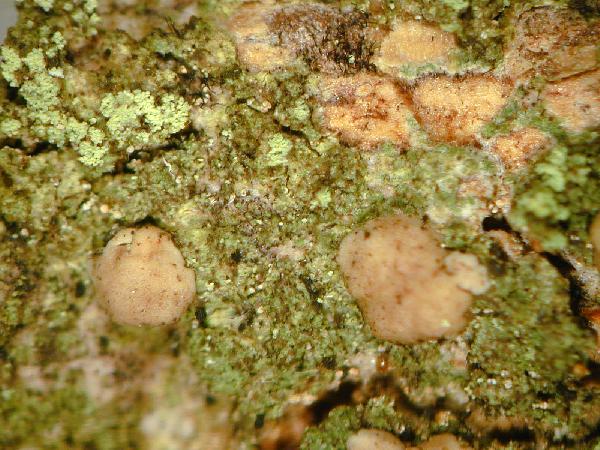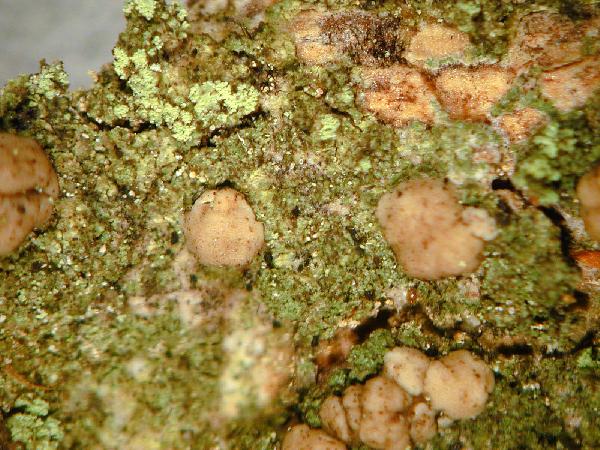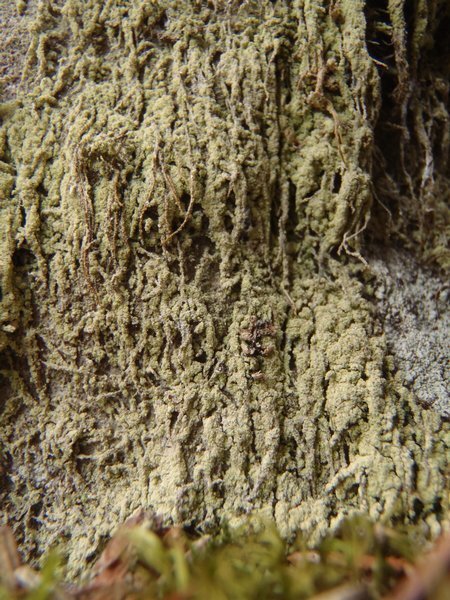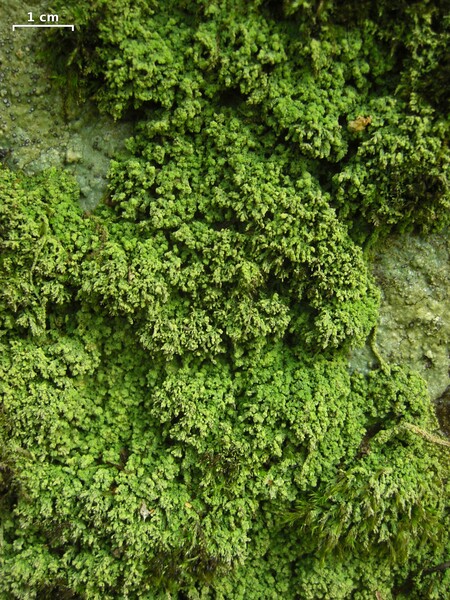Biatora chrysantha (Zahlbr.) Printzen
in Wirth, Stuttgarter Beitr. Naturk., A 517: 62, 1994. Basionym: Lecidea chrysantha Zahlbr. - Ann. Mycol., 19: 236, 1921.
Synonyms: Biatora epixanthoidiza auct. non (Nyl.) Räsänen; Biatora gyrophorica (Tønsberg) Coppins; Biatora vernalis var. incana (Ach. ex Sommerf.) Th. Fr.; Lecidea epixanthoidiza auct. non Nyl.; Lecidea gyrophorica Tønsberg; Lecidea incana Ach. ex Sommerf. non (L.) Ach.
Distribution: N - Frl (GZU-524975), Ven (Trevisan Lichenoth. Ven. 59: Printzen 1995, Thor & Nascimbene 2007), TAA (Nascimbene 2005, 2014, Nascimbene & al. 2006e, 2009, 2014, 2022, Trindade & al. 2021), Lomb (Herb. Nascimbene 1753), Piem (TSB 33239), Lig.
Description: Thallus crustose, episubstratic, grey-green to dark green, warted-areolate, the areoles usually convex, incised, almost subsquamulose, 0.1-0.25 mm wide, up to up to 750 μm thick in non-sorediate parts. Soralia yellowish green to pale green, paler than thallus, at first well-delimited and rounded, 0.25-0.7 mm across, but soon confluent and covering the central parts of thallus; soredia 15-30(-40) µm in diam., often forming larger consoredia (50-75 µm in diam). Cortex poorly developed, c. 10 µm thick. Apothecia rare, biatorine, rounded to irregular in outline, sessile with a constricted base, 0.4-1 mm across, with a pale pink to red-brown, epruinose, convex or tuberculate disc, and a thin, slightly paler, soon excluded proper margin. Proper exciple 50-95 μm wide laterally, 70-180 µm wide at base, of radiating, hyaline hyphae with 1.5-2.5 µm wide lumina; epithecium poorly differentiated from the hymenium; hymenium colourless, 40-55 µm high, C-; paraphyses simple, 1.5-2 µm thick at base, apically slightly swollen and 2-3 µm thick; subhymenium distinct, 50-85 µm high; hypothecium colourless or pale yellowish brown, up to 300 µm high. Asci 8-spored, cylindrical-clavate, with a K/I+ blue apical dome penetrated by a narrow, K/I- apical cushion surrounded by a narrow, deeply K/I+ blue zone, the wall K/I- but surrounded by a I+ red-brown and K/I+ blue outer layer, the ocular chamber small, Biatora-type. Ascospores 0(-1)-septate, hyaline, narrowly ellipsoid, (10-)12-16(-20) x (3-)4-6(-7) µm. Photobiont chlorococcoid. Spot tests: thallus and soralia K-, C+ red, KC+ red, P-. Chemistry: gyrophoric acid (major), lecanoric acid (accessory).Note: on epiphytic bryophytes in humid forests, mostly in upland areas.
Growth form: Crustose
Substrata: bark
Photobiont: green algae other than Trentepohlia
Reproductive strategy: mainly asexual, by soredia, or soredia-like structures (e.g. blastidia)
Commonnes-rarity: (info)
Alpine belt: absent
Subalpine belt: very rare
Oromediterranean belt: absent
Montane belt: rare
Submediterranean belt: absent
Padanian area: absent
Humid submediterranean belt: absent
Humid mediterranean belt: absent
Dry mediterranean belt: absent

Predictive model
Herbarium samples
Growth form: Crustose
Substrata: bark
Photobiont: green algae other than Trentepohlia
Reproductive strategy: mainly asexual, by soredia, or soredia-like structures (e.g. blastidia)
Commonnes-rarity: (info)
Alpine belt: absent
Subalpine belt: very rare
Oromediterranean belt: absent
Montane belt: rare
Submediterranean belt: absent
Padanian area: absent
Humid submediterranean belt: absent
Humid mediterranean belt: absent
Dry mediterranean belt: absent

Predictive model
| Herbarium samples |
 Index Fungorum
Index Fungorum
 GBIF
GBIF






